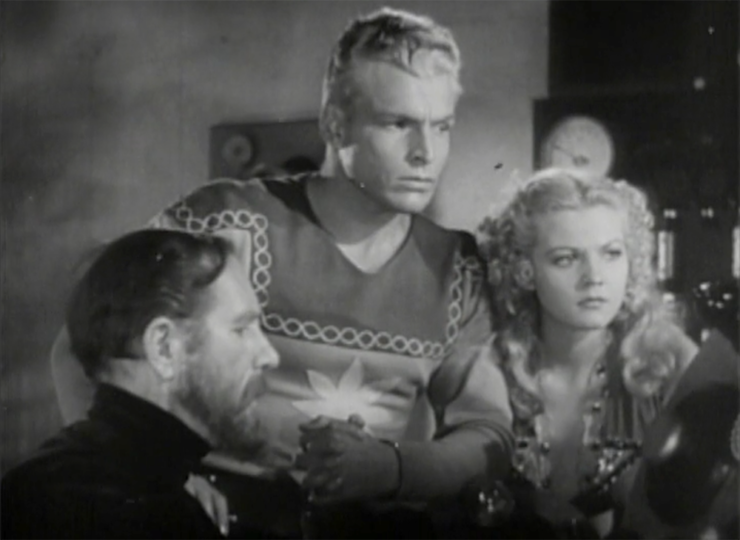One of the first things I watched when I signed up for Netflix was a suspense serial from the silent film era called Phantomas, and while it was very enlightening to see this first step in the evolution of recorded crime dramas, ultimately it… wasn’t very good. Maybe that’s not fair—it had its moments, but I would have a hard time recommending it to anyone but the most curious film archivists.
Thanks to the growth of streaming services, a vast archive of antique entertainment is now easily accessible to the public, though whether it should be or not is a matter of personal opinion. In the case of the Flash Gordon serials that Universal created from 1936 to 1940, the debate over such material’s worth is a significant matter to science fiction fans. The serials, starring Larry “Buster” Crabbe as Flash (a character who had first appeared in newspaper comic strips a few years prior) made a powerful impression which is evident in much of the sci-fi films and shows that followed. You can see a clear impact on EC comics like Weird Science, on the original Star Trek, and of course the 1980 Flash Gordon film. George Lucas acknowledged the influence of the serials on Star Wars—a film he made when he was unable to acquire the Flash Gordon film rights.
So the pre-WWII serials are significant, but are they actually worth watching? With their stock characters, recycled sets, cobbled-together special effects, and disjointed stories, you could argue that they qualify only as pure camp. It’s easy to laugh at Crabbe’s earnest heroics, and even easier to mock the tin-cans-plus-sparklers rockets and hair-dryer laser guns. Moreover, Charles Middleton’s “sinister Asian” mannerisms, borrowed from Fu Manchu, combine with the era’s sexism to invite bemused scorn, at best.
And yet there is no such thing as perfect entertainment, and if films like Guardians of the Galaxy and The Incredibles can offer important life lessons, one of those lessons is that over-the-top silliness and action-packed derring-do can function together in harmony. (How long before subsequent generations look at Thor: Ragnarok with the same wariness that we survey Flash Gordon Conquers the Universe?) When certain expectations are managed, the early Flash Gordon serials are not just enlightening peeks into the formative years of science fiction movies—they’re also enjoyable films on their own, with enough solid adventure and spectacle to make for a fun ride. And, oddly, the longer they run, the better the ride.
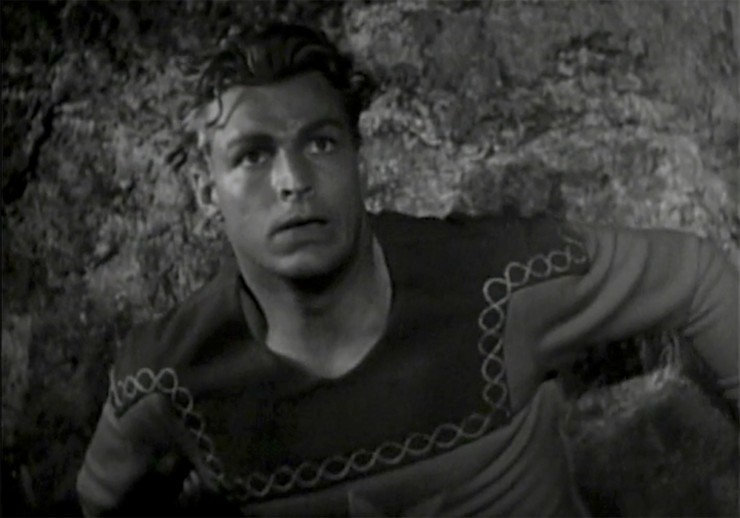
Let’s start with the star, Olympic swimmer Larry “Buster” Crabbe. Crabbe will never ascend to the pantheon of Hollywood greats alongside Paul Newman, Ingrid Bergman, Kirk Douglas, and the rest; he’ll never even make it to the level of Michael J. Fox or Jane Seymour. Yet with his Greek-ideal looks and his athletic build, he may have been, visually, one of the greatest action stars who ever lived. Crabbe’s beefcakeiness is such a part of his Hollywood legacy that even his IMDB profile photo shows him shirtless. And while his acting could be amateurish, it was never bad; when the scripts called for him to wrestle three goons at once, or take a flying leap off a parapet, or scoop up an actress (with ease) and race up a hillside carrying her in his arms, Crabbe could always supplement the action with a look of shock and nervous determination—a nice touch for a guy who looked pretty much unstoppable in every other particular. The only incongruent thing about Crabbe was his voice, which seemed an octave too high and too nasal for such a towering, muscular dude. Think how far he could have gone with Charlton Heston’s deep, commanding bass.
Crabbe first appeared as the polo-player-turned-interplanetary-problem-solver in the 1936 serial simply titled Flash Gordon. While the production may look cheap and the story seems juvenile by today’s standards, in fact the serial had a big budget (Hollywood just didn’t know how to make impressive special effects then) and was aimed at adults as well as kids as its intended audience. And the public at the time ate it up, giving Universal a solid hit and resulting in two more serials starring Crabbe as Gordon, totaling twelve hours and nineteen minutes of imaginative entertainment. Over subsequent decades, those episodes would be re-edited and repackaged in various forms, first for cinema, then for television, then for DVD release, resulting in a confusing abundance of Amazon Prime offerings. (More on all that below.)
While it’s best to watch the serials in their original form, paced out over twenty-minute episodes, a good place to start with this staggering amount of action is Rocket Ship, a film version of the first serial edited down to a little over an hour. Rocket Ship was probably put together in 1936, after the initial serial’s release, then given a new name and reissued again in 1949. The main problem with watching a serial condensed into a single feature is that the episodic nature of the material becomes apparent, and the films have an arbitrary this-happens-then-that-happens feel. Such is the case with Rocket Ship. Nevertheless, the parade of dangers that Flash and his companions scrape through make for gripping action with more than a hint of lunacy. There’s a cave-dwelling monster with giant lobster claws, two decorated iguanas filmed in close-up so that they appear gigantic, an “orangopoid” (a stuntman in a gorilla suit with a rhino horn), an army of winged hawkmen, and plenty of armored thugs loyal to Ming the Merciless, tyrannical ruler of Mongo.
That’s a crazy amount of challenges to throw at a protagonist, made even crazier when squeezed into a feature only a little longer than an hour. And during the course of all the action, Doctor Zarkov whips up inventions, the soldiers of Mongo pursue the Earthpeople, Ming gets hot and sweaty for Dale Arden, and, best of all, Ming’s daughter Aura gets really hot for Flash.
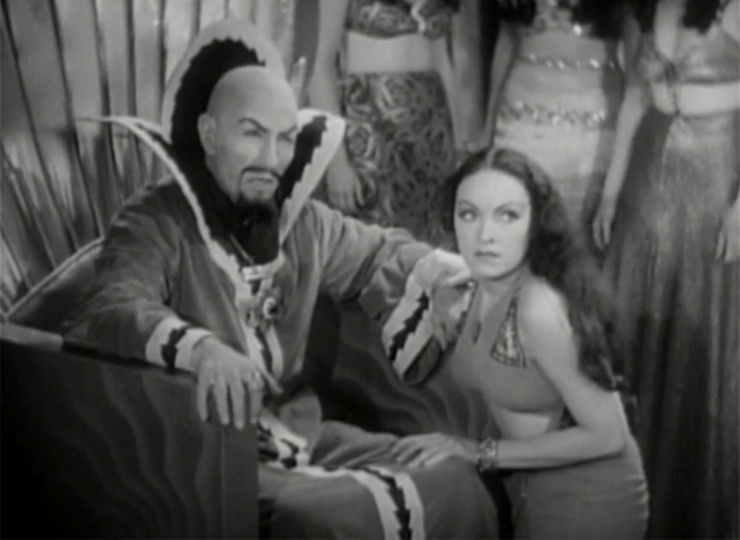
A word here about Priscilla Lawson, the actress who portrayed Aura, and who is described as “voluptuous” in every online bio I’ve read of her. Lawson may be the serial’s MVP, even though she’s hardly a great actress, delivering her lines in a near-monotone even flatter that the droning of Charles Middleton, the actor playing her father. Wearing what is basically a skirt and a sports bra, Lawson elbows her way into several scenes with a look of erotic determination that comes across as simultaneously hilarious, kittenish, and truly intimidating. Breathing heavily and fixing her violent stare on Crabbe, Aura deserves a place in the Space Princess Hall of Fame, just after Leia and Deja Thoris.
The women’s costumes in the serial—Jean Rogers as Dale Arden wears a similar exotic number—caused complaints from the Hollywood censors, and Dale and other women are more covered in subsequent outings. The various costumes are a big part of the fun in these movies, as a wardrobe department raided trunks of older movies to piece together otherworldly regalia for the various races of Mongo. Ming’s guards dress in outfits that combine Roman helmets, military marching band costumes, and various bits of metal plating—including distinctive face-plates—to wonderful effect. Prince Barin and his forest-dwelling subjects wear gear swiped from a Robin Hood film, presumably being shot in a neighboring lot. There are fairy-tale costumes, burlap sacks, and exotic-dancer apparel, and in one part both Flash and Zarkov are decked out in short shorts. The most interesting costume evolution is that of Ming, who first appears in long Mandarin-style silk robes, intended to emphasize (along with his long thin mustache) his Asian-ness. In the second serial, Ming is decked out more like a sci-fi wizard, accessorizing his robe with a belt, a cap, and an even stranger collar than he sported in his first outing; and by the third, released in 1940, Ming wears a military uniform decorated with oversize medals which might put one in mind of ‘70s-era Idi Amin, and even at one point proudly identifies himself not as emperor but as dictator of Mongo. Middleton seems done with any further phony Asian business by 1940, with Ming’s appearance moving from a distinctly Fu Manchu-esque villain to something more along the lines of the Fascists dominating the newsreels of the day.
The second serial was titled Flash Gordon’s Trip to Mars, arriving in 1938; months after its release, Martians declared war on Earth, at least according to Orson Welles, causing a national panic. Universal, knowing an opportunity when they saw one, edited the serial (which totaled almost five hours) down to a one-hour film and re-released it under the title Mars Attacks the World. The short film is available on Amazon for a small fee, but I would advise caution, here. While Rocket Ship is a perfectly good condensation of Flash’s first serial, Mars Attacks the World is badly put together and hard to follow, leaving out some of the best parts. And the version on Amazon has terrible sound and video quality.
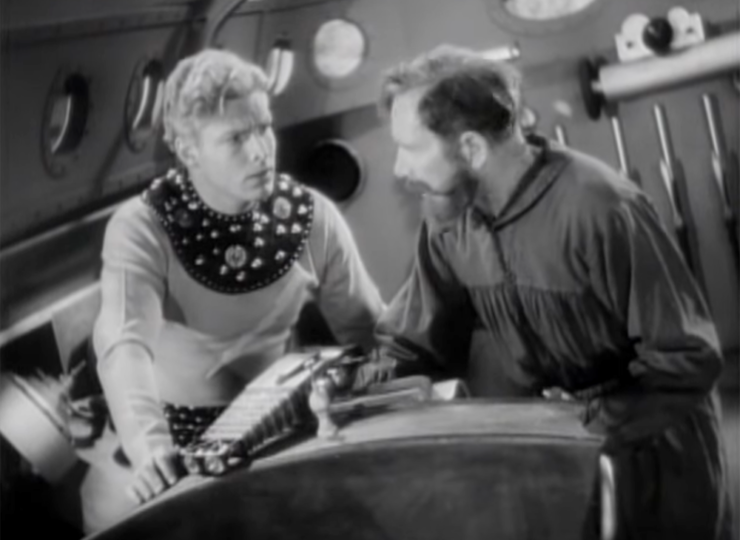
It’s a shame, because the original serial in its entirety is a blast. Amazon—the retail version—sells a complete DVD set from a company called Image Entertainment (now RLJ Entertainment), and this complete version is much higher quality. Plus, we get to see all the adventures, all of the money spent on sets and vehicles, all of the wild costumes, and every wonderful cliffhanger.
And what a story: Ming has turned to his Martian ally Azura, Queen of Magic, to aid him in a plot that increases his arsenal while devastating the Earth. Flash, Dale, and Zarkov get to Mars and discover that Azura has cursed a group of natives now known as the clay people, making them misshapen and unable to exist in daylight (the clay people, by the way, resemble the mutants of Beneath the Planet of the Apes almost exactly, right down to their wardrobes). Much strenuous activity follows, as Flash and company zigzag across Mars, fighting Ming and his goons and seeking to obtain the gems that can break Azura’s curse.
Clearly some cash was spent on the sets, though the frequently-glimpsed Martian skyline is obviously a painted backdrop. But there’s Azura’s palace, a temple of the forest god Kalu, a tower from which Ming launches his destructive beam at Earth, a bridge made of light, and loads of scientific gizmos along the lines of Tesla coils and high-voltage Jacob’s Ladders here and there, to remind everyone that this is truly classic sci-fi.
Crabbe gets the costume that would become Flash’s signature look—black riding pants and boots, a shirt with a lightning bolt, and a collar with large metal rings and studs accessorized by a matching belt. Gone are the short shorts, aside from an outfit worn by Richard Alexander as Flash’s dependable ally Prince Barin which consists of a Roman-style chest plate and what seriously looks like a diaper. Dale spends the movie in an evening gown and heels, as though Fred Astaire is going to take her to the dance floor at any moment. Azura, with her ermine and tiara, looks like she’s auditioning for a role in The Crown.
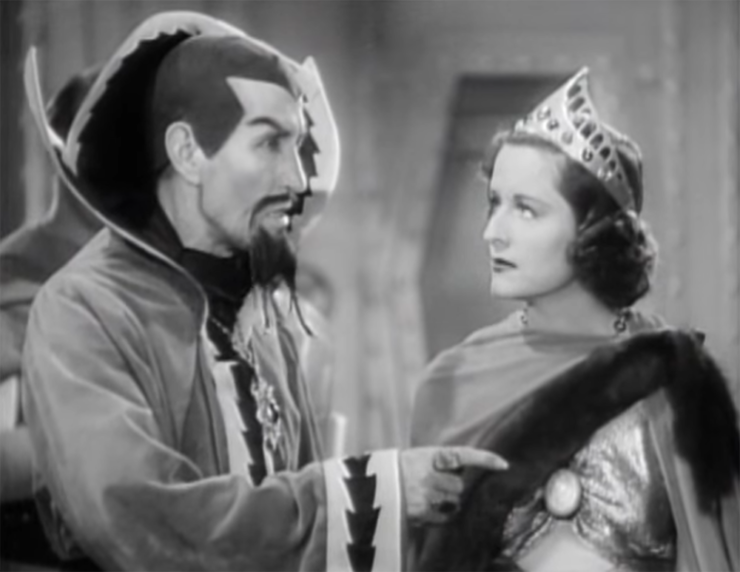
Seeing Azura run the show, confounding our heroes with her powers to mutate people and to teleport in bursts of smoke, is a lot of fun, and she gives Ming plausible reasons for explaining his fiendish plots, something Middleton does well. But Azura seems more interested in looking regal than being evil, and she comes off as haughty more than anything else. Middleton, however, really comes alive as Ming in this serial, for the first and pretty much only time. He cackles, he hisses, he threatens (“Now I shall destroy you once and for all!”); he and Flash even get into some fisticuffs. It’s a nice change from Ming droning commands while parked on his throne. Another welcome change is that Ming has set aside his lust for Dale, and seems far hornier for Flash Gordon’s destruction than for his girlfriend.
Dale also gets some stuff to do beyond shouting the occasional “Look, Flash!” and screaming. She steals a rocket ship in one scene and rushes to Flash’s rescue, and in another she’s brainwashed and jabs a dagger into Flash’s back—how’s that for a cliffhanger! But Jean Rogers apparently didn’t enjoy doing these serials and was replaced, in the third one, by Carol Hughes…who also never quite had enough to do.
If you’ve seen other Flash Gordon offerings on streaming services and are hungry for more, definitely track down the DVD of Flash Gordon’s Trip to Mars, but skip the condensed version—it doesn’t do the original any favors.
Flash Gordon Conquers the Universe is the only one of the three serials that can be watched in its entirety on Amazon Prime. If you’re into this stuff, then watching a few episodes at a time is the best way to approach it; the storytelling was meant to be delivered in small doses, and cliffhanger endings keep one’s interest, even if it’s hard to take all of them seriously. Back in power on Mongo, Ming is menacing Earth with a purple ray that causes death via a plague. Scenes of panic in the streets are just that—actual footage of rallies and riots taken from newsreels—and it’s not hard to make an analogy between the spread of the purple death and, in the real world, the nations of 1940 marching to war.
Flash returns to Mongo with Dale and Zarkov, and does what he always does—fights weird creatures, punches Ming’s guards, dangles from ropes, and rescues Zarkov and the rest, who need saving roughly every five minutes. There are rock men who speak backwards, sword-fights, an army of robots, explosions, and so much happening in general that no one will ever label Mongo as a boring place to visit. There’s also another space princess who wouldn’t mind piloting Flash’s rocket ship, if you know what I’m saying, but even though Anne Gwynne is a fine actress, she’s no Priscilla Lawson. Aura actually is present in this serial as well, but she’s played by a new actress and has become a lot tamer now that she’s settled down with Prince Barin.

Flash Gordon Conquers the Universe was re-cut into not one but two films, both of which are available on Amazon Prime for a fee: Purple Death from Outer Space and Perils of the Planet Mongo.
In the fifties, the serials were broadcast on television, but because the DuMont Network was airing a new (and by all accounts inferior) Flash Gordon series, the serials were retitled Space Soldiers, Space Soldiers’ Trip to Mars, and Space Soldiers Conquer the Universe. The film versions of the serials were aired as well, re-edited again in the ‘60s. In the early 1970s—in a move that perhaps prophesied the arrival of Star Wars—public television showed the serials in their entirety.
To return to the question of whether or not these serials are good; given that a lot of today’s sci-fi fans were raised on a similar diet, I’d say that even viewers with little tolerance for camp will enjoy these offerings. The serialized stories reminded me of watching ‘80s-era Doctor Who episodes on PBS, which broke up episodes into five short shows, shown on subsequent weeknights. And since Chris Evans’ earnest heroics in the MCU have won him an army of fans in recent years, those people will find a lot to like about Crabbe’s similar onscreen exploits, even if Evans is a better actor (but Crabbe’s better looking). Plus, anyone wanting to look under the hood of the Star Wars movies—anyone who’s sought out Fritz Lang’s Metropolis or Akira Kurosawa’s Hidden Fortress—will find a wealth of otherworldly spectacle in these serials that clearly left a major impact on Lucas, and for that matter Spielberg and many others. Keep in mind the fact that the Flash Gordon serials were regularly shown on television in one form or another throughout the ‘50s and ‘60s, and represented the pinnacle of fantastic entertainment for decades. The campiness of the Flash Gordon serials is thick and the effects are laughable, but this is a rocket ship that we boarded a long, long time ago—and it still flies.
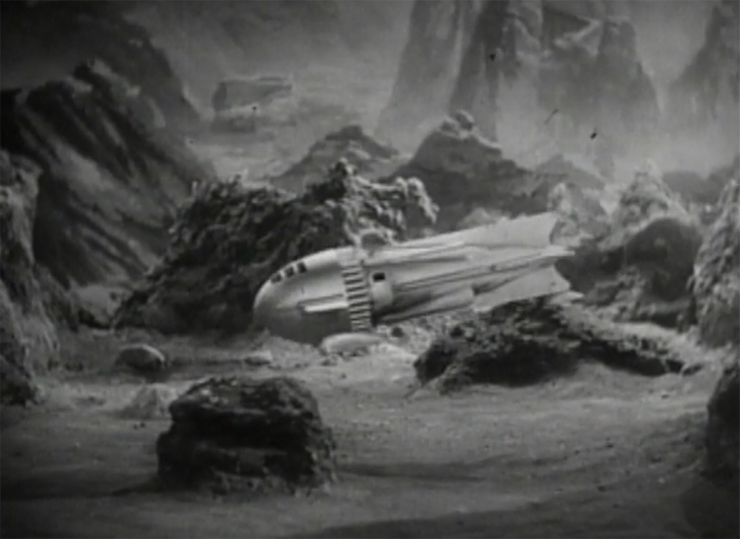
A Quick Guide to Universal’s Flash Gordon Serials
Flash Gordon (1936)
Re-edited as:
- Rocket Ship (1949) — Feature film constructed from serial (Available on Amazon Prime)
- Space Soldiers (1950s) — Serial for TV
- Spaceship to the Unknown (1966) — Film for TV (Listed on Prime but unavailable)
Flash Gordon’s Trip to Mars (1938)
Re-edited as:
- Mars Attacks the World (1938) — Feature film constructed from serial (Available for rent or purchase on Amazon Prime)
- Space Soldiers Trip to Mars (1950s) — Serial for TV
- The Deadly Ray from Mars (1960s) — Film for TV
Flash Gordon Conquers the Universe (1940) (Available for rent or purchase on Amazon Prime)
Re-edited as:
- Purple Death from Outer Space (1966)— Film for TV (Rent or purchase on Prime; there seem to be two versions available—one listed as 2002, 1h 28m, and another listed as 2016, 1h 27m)
- Perils of the Planet Mongo (1966) — Film for TV (Listed on Prime but unavailable)
Hector DeJean relives the pop-culture highlights of his misspent youth every day in his head. He’s written about television, superheroes, and TV superheroes for the Criminal Element.










